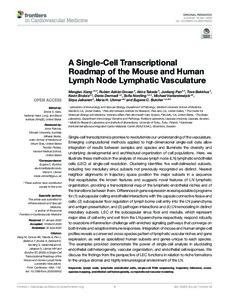A Single-Cell Transcriptional Roadmap of the Mouse and Human Lymph Node Lymphatic Vasculature
Kevin Brulois; Tove Bekkhus; Akira Takeda; Michael Vanlandewijck; Menglan Xiang; Rubén Adrián Grosso; Eugene C. Butcher; Maria H. Ulvmar; Sirpa Jalkanen; Junliang Pan; Sofia Nordling; Denis Dermadi
A Single-Cell Transcriptional Roadmap of the Mouse and Human Lymph Node Lymphatic Vasculature
Kevin Brulois
Tove Bekkhus
Akira Takeda
Michael Vanlandewijck
Menglan Xiang
Rubén Adrián Grosso
Eugene C. Butcher
Maria H. Ulvmar
Sirpa Jalkanen
Junliang Pan
Sofia Nordling
Denis Dermadi
FRONTIERS MEDIA SA
Julkaisun pysyvä osoite on:
https://urn.fi/URN:NBN:fi-fe2021042826691
https://urn.fi/URN:NBN:fi-fe2021042826691
Tiivistelmä
Single-cell transcriptomics promise to revolutionize our understanding of the vasculature. Emerging computational methods applied to high-dimensional single-cell data allow integration of results between samples and species and illuminate the diversity and underlying developmental and architectural organization of cell populations. Here, we illustrate these methods in the analysis of mouse lymph node (LN) lymphatic endothelial cells (LEC) at single-cell resolution. Clustering identifies five well-delineated subsets, including two medullary sinus subsets not previously recognized as distinct. Nearest neighbor alignments in trajectory space position the major subsets in a sequence that recapitulates the known features and suggests novel features of LN lymphatic organization, providing a transcriptional map of the lymphatic endothelial niches and of the transitions between them. Differences in gene expression reveal specialized programs for (1) subcapsular ceiling endothelial interactions with the capsule connective tissue and cells; (2) subcapsular floor regulation of lymph borne cell entry into the LN parenchyma and antigen presentation; and (3) pathogen interactions and (4) LN remodeling in distinct medullary subsets. LEC of the subcapsular sinus floor and medulla, which represent major sites of cell entry and exit from the LN parenchyma respectively, respond robustly to oxazolone inflammation challenge with enriched signaling pathways that converge on both innate and adaptive immune responses. Integration of mouse and human single-cell profiles reveals a conserved cross-species pattern of lymphatic vascular niches and gene expression, as well as specialized human subsets and genes unique to each species. The examples provided demonstrate the power of single-cell analysis in elucidating endothelial cell heterogeneity, vascular organization, and endothelial cell responses. We discuss the findings from the perspective of LEC functions in relation to niche formations in the unique stromal and highly immunological environment of the LN.
Kokoelmat
- Rinnakkaistallenteet [19207]
